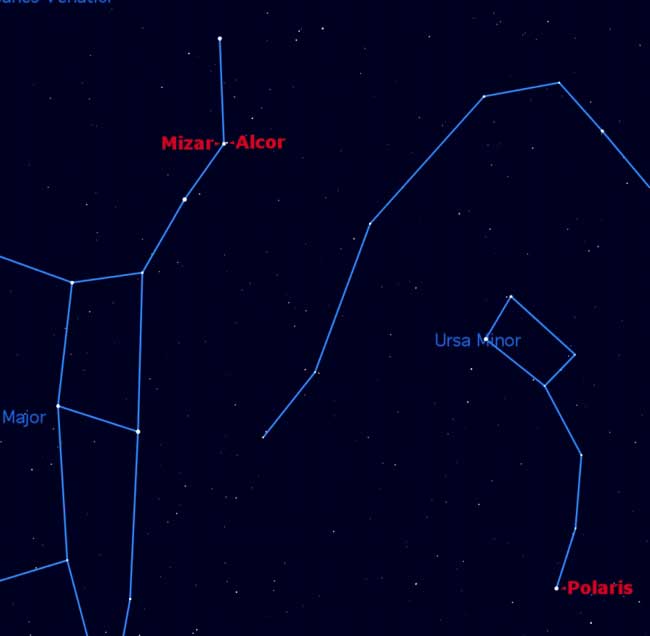Seeing Double: When One Star is Really Two

What is there to look at with a small telescope when the light from the Full Moon floods the sky? Galaxies and nebulae are swamped by the moon's natural "light pollution." Starlight still shines through, and gives astronomers some different targets to observe.
Nearly half of the stars in the sky are double or multiple. Many of these show startling contrasts in color and brightness, and are showpieces in even the smallest of telescopes.
If you look closely at Mizar, the star in the middle of the Big Dipper's handle, you may detect that it has a tiny companion. This star, Alcor, was known to the ancients, and was sometimes used as a test for good vision. In any binoculars, Alcor can be plainly seen as a separate star.
Not surprisingly, this was one of the first objects the earliest telescopes were turned on. In 1617 Benedetto Castelli wrote to his friend Galileo telling him that Mizar itself was also a double star, and asking Galileo to observe it and confirm this. This was the first binary star to be discovered. In 1889, Edward Charles Pickering turned his spectroscope on Mizar A, and discovered that it was also a close binary, the first spectroscopic binary discovered. There are few stars in the sky that have as many "firsts" as Mizar does!
Take a look at Mizar with whatever optical aid you have available. With the naked eye, you should be able to see it as a double, Mizar and Alcor, 12 arcminutes apart, nearly half the apparent diameter of the moon. With a small telescope, you will see Mizar split into a double, Mizar A and Mizar B, 14 arcseconds apart. There is also a fourth star in the system, roughly half way between Mizar and Alcor, but off to the side.
The two stars which make up Mizar itself are almost equal in brightness (2.3 and 3.8 magnitude) and colour. The other double star we're going to look at, Albireo, is a contrast in both brightness and colour.
Albireo is an easy star to locate on these warm June evenings. Around 11 p.m. Cygnus the swan appears above the eastern horizon, flying southward with its long neck extended. Albireo forms the head of the swan. Although it can just be split with binoculars and a steady hand, it is best seen with a small telescope. Its wide separation of 35 arcseconds makes it easy to split in the smallest telescope.
Get the Space.com Newsletter
Breaking space news, the latest updates on rocket launches, skywatching events and more!
The brighter of Albireo's two components is a 3rd magnitude yellow giant. Its companion is very different: two magnitudes fainter and deep blue in color. This contrast of brightness and color makes Albireo one of the prettiest sights possible in a small telescope.
Amateur astronomers in the 19th and early 20th centuries devoted much attention to double stars, but they are overlooked and neglected by many modern amateurs in their search for fainter and fuzzier deep sky objects. The recent return of refractors to popularity seems to have made double stars targets of interest again. May Mizar, Alcor, and Albireo be the first of many pretty doubles to grace the eyepiece of your telescope!
This article was provided to SPACE.com by Starry Night Education, the leader in space science curriculum solutions.
Join our Space Forums to keep talking space on the latest missions, night sky and more! And if you have a news tip, correction or comment, let us know at: community@space.com.

Geoff Gaherty was Space.com's Night Sky columnist and in partnership with Starry Night software and a dedicated amateur astronomer who sought to share the wonders of the night sky with the world. Based in Canada, Geoff studied mathematics and physics at McGill University and earned a Ph.D. in anthropology from the University of Toronto, all while pursuing a passion for the night sky and serving as an astronomy communicator. He credited a partial solar eclipse observed in 1946 (at age 5) and his 1957 sighting of the Comet Arend-Roland as a teenager for sparking his interest in amateur astronomy. In 2008, Geoff won the Chant Medal from the Royal Astronomical Society of Canada, an award given to a Canadian amateur astronomer in recognition of their lifetime achievements. Sadly, Geoff passed away July 7, 2016 due to complications from a kidney transplant, but his legacy continues at Starry Night.
